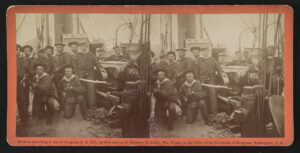The Franco-Prussian War Primer
The War at Sea
While French and German forces were fighting large, pitched battles on land, it was quite different at sea. The French navy far outclassed the navy of the North German Confederation, with 45 ironclads compared to the five armored vessels of the German fleet.[1] Immediately upon the declaration of war, the French fleet set sail to blockade the German coastline, with the German fleet left on the defensive with little opportunity to retaliate.[2] There was also the possibility of a French naval landing on the North German coast, possibly in coordination with a Danish invasion. However, this landing and Danish invasion never materialized, and the Germans did not see the need to divert forces to their coast as a precaution, leaving the task to the local garrisons.[3] As the war drew on, it became clear that things weren’t going perfectly for the French fleet. Prior to the war, the French had plans for actions against other nations such as Britain or Spain, but not against the minor naval power of Prussia or the newly formed North German Confederation. This lack of planning became apparent as logistical issues reared their head and the blockade’s effectiveness dropped, allowing blockade runners and the occasional German navy ship to take advantage of the situation.[4] By the end of the war, the only naval battle between the two sides would be a case of mutual combat that occurred off the coast of Cuba, between a single French aviso and a German gunboat, with action ending inconclusively. The French navy would play a more prominent role on land through their sailors and gun crews that transferred over to fight the German army.[5]
[1] Geoffrey Wawro, The Franco-Prussian War: The German Conquest of France in 1870–1871, Cambridge, UK: Cambridge University Press, 2003, 188-189
[2] Pflugk-Harttung, The Franco-German War, 60
[3] Moltke, Extracts, P.136-137
[4] Wawro, The Franco-Prussian War, 190-192
[5] Pflugk-Harttung, The Franco-German War, 588-592
